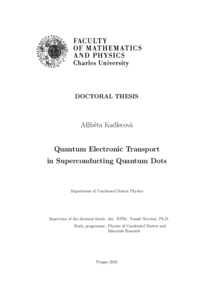Quantum electronic transport in superconducting quantum dots
Kvantový elektronický transport v supravodivých kvantových tečkách
dissertation thesis (DEFENDED)

View/
Permanent link
http://hdl.handle.net/20.500.11956/151501Identifiers
Study Information System: 177013
CU Caralogue: 9925465388306986
Collections
- Kvalifikační práce [11349]
Author
Advisor
Consultant
Žonda, Martin
Referee
Kos, Šimon
Munzar, Dominik
Faculty / Institute
Faculty of Mathematics and Physics
Discipline
Physics of Condensed Matter and Materials Research
Department
Department of Condensed Matter Physics
Date of defense
22. 9. 2021
Publisher
Univerzita Karlova, Matematicko-fyzikální fakultaLanguage
English
Grade
Pass
Keywords (Czech)
Kvantová tečka|Supravodivost|Josephsonův jev|NanostrukturyKeywords (English)
Quantum dot|Superconductivity|Josephson effect|NanostructuresPráce se zabývá teorií kvantové tečky tvořené jednou energetickou hladinou s korelovanými elektrony, která je připojená na dva BCS supravodivé přívody. Je-li mezi supravodiči fázový rozdíl, nastává stejnosměrný Josephsonův jev, při kterém teče spojem supraproud. V tomto systému zkoumáme vliv asymetrie vazeb mezi tečkou a přívody na transportní vlastnosti. Analyticky odvozujeme, že asymetrie vazeb a fázový rozdíl jsou provázané veličiny, a ze znalosti fyziky efektivního symetricky vázaného systému lze dopočítat fyziku systému s libovolnou asymetrií. Asymetrie vazeb je důležitý parametr, který ovlivňuje mimo jiné pozici kvantového fázového přechodu i v silně korelovaném, tzv. Kondově, režimu. Práce dále přispívá k interpretaci měření střídavého Josephsonova proudu ve spoji s kvantovou tečkou pod napětím, kde byl pozorován překvapivý pokles amplitudy proudu v Kondově režimu. Systém charakterizujeme pomocí rovnovážných mnohočásticových spekter spočtených numerickou renormalizační grupou. Dále diskutujeme možné interpretace pozorovaného poklesu proudu na základě teorie známé pro kvantový bodový kontakt. Zjišťujeme, že ačkoli pokles proudu na daném napětí nastává i v kvantovém bodovém kontaktu, fyzikální mechanismy, které ho způsobují, se zřejmě liší.
In this thesis, the single-level correlated quantum dot attached to two BCS superconducting leads is analyzed. A difference in the superconducting phases of the leads induces the DC Josephson supercurrent in the junction. In this setup, the influence of asymmetrical dot-lead couplings on transport properties is clarified analytically. The coupling asymmetry and the phase difference can be combined into one function, which allows us to calculate physical properties of a system with coupling asymmetry from the properties of its effective symmetric counterpart. The coupling asymmetry turns out to be an important parameter which influences the position of the 0 − � quantum phase transition even in the strongly correlated Kondo regime. Further, this thesis contributes to the interpretation of an AC Josephson current measurement, in which a surprising drop in the amplitude was observed in the Kondo regime. The experimental setup is characterized using numerical renormalization group calculations of the equilibrium many-body spectra. Possible quantum-point-contact- based interpretations are discussed. Although a drop in the AC Josephson current at the experimental bias voltage is also expected in a quantum point contact, we conclude that the physical mechanisms causing it in the quantum dot system are likely not...
